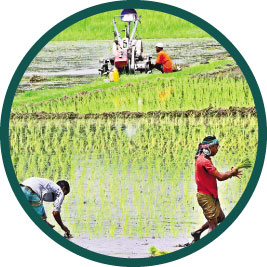 In recent times, it is often said that the country's agrarian economy is experiencing a shift from farm activities to non-farm activities. Non-farm activities and urban migration are commonly believed to have left a significant impact on rural farm landscape, especially agriculture, but how far these are reflected positively or negatively in rural economy remains an important question.
In recent times, it is often said that the country's agrarian economy is experiencing a shift from farm activities to non-farm activities. Non-farm activities and urban migration are commonly believed to have left a significant impact on rural farm landscape, especially agriculture, but how far these are reflected positively or negatively in rural economy remains an important question.
A study released recently at the annual BIDS Conference on Development 2021, however, has come up with findings that say poverty alleviation efforts in rural Bangladesh have floundered following the country's rapid shift from agrarian economy to service and industry sector-led economy. Researchers suggested reforming agricultural policies to support a more diversified and modernised agricultural production system, introducing high-value crops, and agro-skill development to sustain poverty alleviation achievements. The country's poverty reduction was mostly driven by agriculture followed by development of service and industrial sectors; though the recent trends show service sector has become the key driver of poverty alleviation, the study says. This has been substantiated by data: during 2000 to 2005, agriculture contributed about 40 per cent to poverty reduction efforts while the share increased over 70 per cent during 2005-2010. However, in later years, between 2010 and 2016, service sector accounted for over 38 per cent of poverty reduction as against 28 per cent contribution of agriculture. Industrial sector also emerged as a major driver of poverty reduction by contributing about 22 per cent from 2010 to 2016.
Another study conducted by the Bangladesh Bureau of Statistics (BBS) some time ago found that rural households earn more from non-farm activities than what many believe to be the main source of rural income -- agriculture-centric farm activities. This, no doubt, constitutes a shift in the pattern of activities that characterises rural incomes.
Farm activities typically refer to four main components -- crops, livestock, fisheries and poultry. The non-farm activities, on the other hand, include all economic activities in rural areas except the aforementioned activities. These, broadly speaking, include mostly manual labour-based activities, self-employed subsistence-oriented cottage industries, wage employment in rural business activities, transport operation, construction labour and so on. Physical and labour-intensive non-farm areas of activities include commercial type rural industries, including agro-processing, shop-keeping, peddling, petty trading etc. Rural non-farm activity is further qualified by any earning activity that the workers undertake in their own villages, neighbouring villages, growth centres, townships or cities.
According to the BBS survey, of the average annual income of the rural population, 22.77 per cent comes from agriculture and 77.23 from the non-agriculture sector. The reasons attributed to this are believed to be the high production cost for agriculture, problems in marketing and storage resulting in lower prices of products. As a result, farmers do not get returns proportionate to their investment. To cope with the challenges, there is obviously the need for making the marketing and storage system of agricultural products more efficient, while facilitating production by way of increased subsidies in fertiliser and other production inputs like diesel. The main difficulties in post-harvest times are triggered by the dearth of appropriate storage facilities -- cold storages, for example, in respect of horticulture products like potato. Coupled with it is the well known problem of transportation of produces to nearby marketing/wholesale hubs, which automatically gives rise to the increasing intervention by intermediaries who manipulate the prices to the misery of farmers at large. Although much is said on various occasions to minimise the role of the intermediaries of various hues in the distribution system, the reality remains that in times immediately following the harvesting season, farmers are in most cases left with little or no choice but to part with their produce at whatever prices they are offered by the middlemen/intermediaries. The situation could have been otherwise if subsidised transportation could be offered to them, as is the case with some of our neighbouring countries.
That lower earning from farm activities than non-farm activities is a problem sounds rather simplistic, even erroneous, assessment of the situation. Why is non-farm activities more rewarding is a question the policymakers, planners and economists should examine and analyse critically. To narrow down the urban-rural gap, a substantial economic diversification has been taking place in rural areas over decades. This has been augmented, in large part, by the introduction of technology and access to a myriad range of activities hitherto unknown in rural Bangladesh. Overseas remittance has also played a vital role in this regard. While remittance raises the level of non-farm income of many rural households, it also adds to diversion of the traditional focus from agriculture to non-agricultural engagements.
Consideration of the gainful returns from non-farm activities less conducive compared to farm activities is inappropriate. While there is the need for further energising the farm sector, especially the agriculture sector, government policies should also be focused on making rural non-farm activities more and more rewarding. This is particularly so, because many non-farm activities are entrepreneurship-oriented. In this context, it is important to see both these sectors complementing each other. With a view to promoting farm and non-farm sectors alike and strengthening potential linkages between them, there is the need for reforming the institutions responsible for rural development as well as facilitating activities and projects that would enhance farm and non-farm linkages.
wasiahmed.bd@gmail.com
© 2025 - All Rights with The Financial Express
